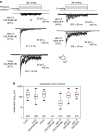A mechanosensitive Ca2+ channel activity is dependent on the developmental regulator DEK1
- PMID: 29044106
- PMCID: PMC5647327
- DOI: 10.1038/s41467-017-00878-w
A mechanosensitive Ca2+ channel activity is dependent on the developmental regulator DEK1
Abstract
Responses of cells to mechanical stress are thought to be critical in coordinating growth and development. Consistent with this idea, mechanically activated channels play important roles in animal development. For example, the PIEZO1 channel controls cell division and epithelial-layer integrity and is necessary for vascular development in mammals. In plants, the actual contribution of mechanoperception to development remains questionable because very few putative mechanosensors have been identified and the phenotypes of the corresponding mutants are rather mild. Here, we show that the Arabidopsis Defective Kernel 1 (DEK1) protein, which is essential for development beyond early embryogenesis, is associated with a mechanically activated Ca2+ current in planta, suggesting that perception of mechanical stress plays a critical role in plant development.
Conflict of interest statement
The authors declare no competing financial interests.
Figures



References
Publication types
MeSH terms
Substances
Grants and funding
LinkOut - more resources
Full Text Sources
Other Literature Sources
Molecular Biology Databases
Miscellaneous

